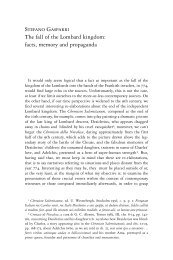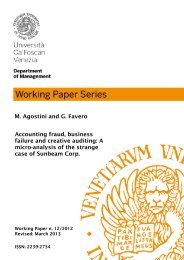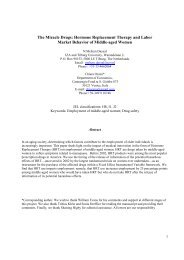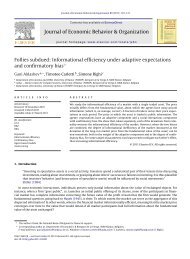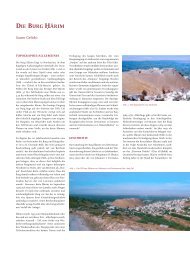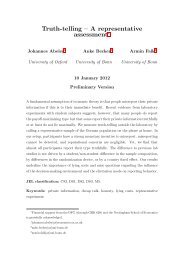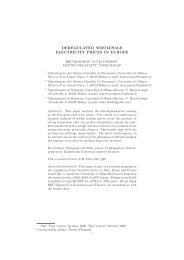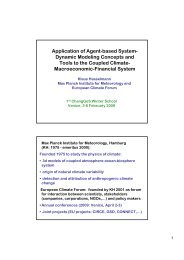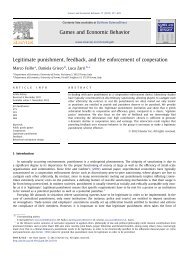The pilot area of Auronzo di Cadore (Belluno) - Università Ca
The pilot area of Auronzo di Cadore (Belluno) - Università Ca
The pilot area of Auronzo di Cadore (Belluno) - Università Ca
Create successful ePaper yourself
Turn your PDF publications into a flip-book with our unique Google optimized e-Paper software.
conceived during the<br />
EU FP5 project MULINO<br />
“MULtisectoral, INtegrated<br />
and Operational Decision<br />
Support System for<br />
sustainable use <strong>of</strong> water<br />
resource at the catchment<br />
scale”<br />
(2)<br />
16<br />
ous step, Actor analysis) hold <strong>di</strong>fferent perceptions and beliefs about<br />
what are the causes <strong>of</strong> the problem or how it should be tackled. Different<br />
techniques have been developed to surface tacit knowledge and deeply<br />
held beliefs, inclu<strong>di</strong>ng conflict assessment, problem-structuring methods,<br />
<strong>di</strong>scourse analysis. <strong>The</strong> in<strong>di</strong>vidual perspectives are further elaborated<br />
in the next step (Creative system modelling) to facilitate collective<br />
learning and shared (agreed) boundaries <strong>of</strong> the problem. <strong>The</strong> main<br />
outputs <strong>of</strong> this phase are: (i) a list <strong>of</strong> most relevant drivers governing<br />
the perception <strong>of</strong> the problem at hand; (ii) a preliminary list <strong>of</strong> possible<br />
solutions can<strong>di</strong>date to be assessed; (iii) A set <strong>of</strong> scenarios regar<strong>di</strong>ng the<br />
future development <strong>of</strong> the main drivers and cause-effect relations; (iv)<br />
an extensive list <strong>of</strong> in<strong>di</strong>cators against which the performance <strong>of</strong> the possible<br />
solutions (alternative options) should be measured.<br />
3. Creative system modelling / (CSM), to represent in a correct<br />
manner the knowledge, opinions, and the preferences <strong>of</strong> the stakeholders<br />
involved. <strong>The</strong> key actors gather in a meeting during which the<br />
problem is conceptualised through the construction <strong>of</strong> cognitive maps<br />
- in<strong>di</strong>vidual and/or collective. Such exercises, elicited accor<strong>di</strong>ng to the<br />
context, allow the representation <strong>of</strong> the various understan<strong>di</strong>ng <strong>of</strong> the<br />
system under analysis. During this phase one can also proceed to the<br />
shared construction <strong>of</strong> the cause-effect chains, through either the conceptual<br />
model DPSIR (Determinants, Pressures, State, Impacts, and Response)<br />
or the elaboration <strong>of</strong> future scenarios that stimulate the identification<br />
<strong>of</strong> potential solutions/ innovative approaches to the problem<br />
under scrutiny.<br />
4. DSS Design / In this phase, all the information gathered during<br />
the previous phases <strong>of</strong> the NetSyMoD methodology are assembled<br />
through the Decision-Support-System ClimAlpTour e-tool, an updated<br />
version <strong>of</strong> mDSS, a s<strong>of</strong>tware (2) , capable <strong>of</strong> managing the data required<br />
for provi<strong>di</strong>ng informed and robust decision in the following phase. <strong>The</strong><br />
latest version <strong>of</strong> the ClimAlpTour e-tool adds a multicriteria spatial analysis<br />
to the previous mDSS versions. This is necessary to manage and<br />
communicating the information flow between various process phases,<br />
inclu<strong>di</strong>ng exchange, transformation, integration, validation and documentation<br />
<strong>of</strong> gathered knowledge. Many <strong>of</strong> the previous analyses employ<br />
computer-based tools such as databases (and data management<br />
systems), visualisation components, and simulation models. Different<br />
tools are frequently assembled into a comprehensive Decision Support<br />
Systems, normally employing various interconnected and adapted<br />
components, controlled by an user interface.<br />
This phase address all activities related to the development <strong>of</strong> interoperable<br />
and useable s<strong>of</strong>tware components; and collection <strong>of</strong> well-documented<br />
and easily exchangeable data sets (inclu<strong>di</strong>ng spatial data and<br />
time series). In the end, one <strong>di</strong>sposes <strong>of</strong> (i) seamless data flow between<br />
various tools and s<strong>of</strong>tware component; (ii) user interface which guides




